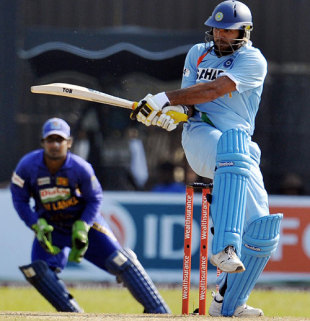|
|
|

Yuvraj Singh did not need to take risks in order to score because of the number of balls he got on leg stump
© AFP
|
|
| |
How wide is the gulf between victory and defeat in a one-sided ODI? Today, that distance was determined by the difference in the quality of bowling by India and Sri Lanka in the Powerplay overs.
To say Sri Lanka's bowling was poor would be understating it. That Yuvraj hit 82 runs on the leg side is one indication of how wayward their lines were. Another is Farveez Maharoof leaking 68 runs in seven overs while almost consistently targeting the pads; so too Dilhara Fernando's problems with the front-foot no-ball. The argument that the batsmen did not allow the bowlers to settle into rhythm simply doesn't hold given the lines adopted by Sri Lanka's attack.
Yuvraj indulged himself so much in an erratic attack that he did not have to impose himself against his nemesis Ajantha Mendis, off whom he took 12 runs in 14 deliveries. The tactical battle had already been won.
Mahela Jayawardene admitted as much. "I am disappointed with the bowling," he said. "When they [India] put us under the pressure, the bowlers couldn't adjust. In the Powerplays, we had set fields but we didn't bowl the right lines. It's something we
have talked about but we have not done it. And that has let us down today."
Sri Lanka took the bowling Powerplay in the 12th over and conceded 50 runs in five overs. Maharoof overpitched and strayed on to the pads with fine-leg in the circle. As a result, four out of the seven boundaries Yuvraj took off him came in that region. Dilhara Fernando, the other bowler used during the Powerplay, was guilty of the same mistake and conceded two out of his three fours at fine leg.
The bowling Powerplay ended after the 16th over but India decided to increase momentum by taking the batting Powerplay immediately. When Jayawardene brought on Muttiah Muralitharan and Mendis, Virender Sehwag stepped in to attack them. He put away two short deliveries from Mendis with panache, and lapped Murali around the corner before lofting him inside out to the cover boundary. India scored 43 runs off their Powerplay and progressed to 167 for 2, virtually killing the contest right there.
The performance of India's bowlers during the Powerplays of Sri Lanka's innings provided stark contrast. They were undeniably under less pressure, defending a total of 363, but the lines bowled were far superior.
Although Sri Lanka managed to score 39 off India's bowling Powerplay, the difference lay in the risks they were forced to take, the manner in which they had to earn their runs. Jayawardene played two flamboyant but risky flicks against Ishant Sharma, hitting the ball from outside off over midwicket, and once exposed his stumps to make room and hit the ball over extra cover. Kumar Sangakkara had to charge Zaheer to hit him for a boundary. India simpy didn't need to take such risks while they batted.
Sri Lanka were 95 for 2 after 15 overs when they gambled by taking the batting Powerplay. It was a tricky decision to make for Mahela Jayawardene because both Kumar Sangakkara and he were well set. Do you keep those five overs towards the business end of a chase? Or do you give your set batsmen five more overs of fielding restrictions to exploit?
"Well the required run-rate was so high we decided to take it," Mahela explained later. "Yes the spinners might have come on but the wicket was beginning to get slow and turn. If we had lost wickets, the batting Powerplay might have been wasted. So we thought, since we were going well, let's take it."
Praveen Kumar rose to the challenge by bowling a series of slower ones, mixing his pace and length, while Zaheer Khan focused on hitting the blockhole. As the asking rate approached eight in the 19th over, Jayawardene jumped out of his crease, trying to hit Praveen inside out, but holed out instead. It was one risk too many. Sri Lanka scored only 26 in that Powerplay and the task proved too much for Sangakkara.
Gary Kirsten had said earlier that this Indian team could win even if they played at 60% efficiency. That may be a debatable statement but there's no doubt that Sri Lanka cannot win if they play at 60%. They need to step up.
Sriram Veera is a staff writer at Cricinfo
